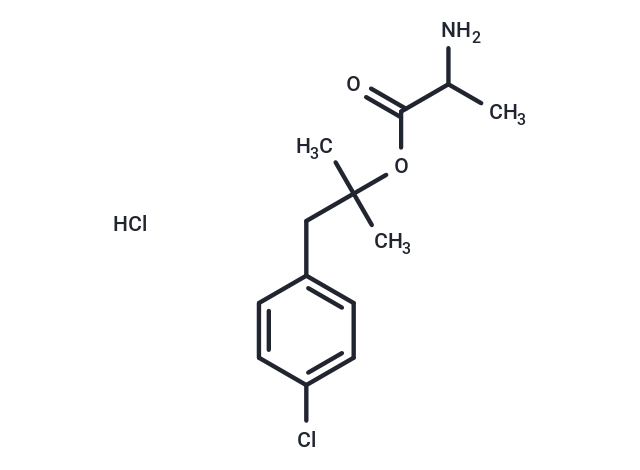- Remove All
 Your shopping cart is currently empty
Your shopping cart is currently empty
Alaproclate (hydrochloride)
Alaproclate is a selective serotonin reuptake inhibitor (SSRI).1,2 It inhibits depletion of serotonin (5-HT) induced by 4-methyl-α-ethyl-m-tyramine in rat cerebral cortex, hippocampus, hypothalamus, and striatum (EC50s = 18, 4, 8, and 12 mg/kg, respectively).1 Alaproclate inhibits NMDA-evoked currents and depolarization-induced voltage-dependent potassium currents in rat hippocampal neurons (IC50s = 1.1 and 6.9 μM, respectively) and does not inhibit GABA-evoked currents when used at concentrations up to 100 μM.2 It increases sirtuin 1 (SIRT1) levels in N2a murine neuroblastoma cells expressing apolipoprotein E4 (ApoE4; IC50 = 2.3 μM) and in the hippocampus in the FXFAD-ApoE4 transgenic mouse model of Alzheimer's disease when administered at a dose of 20 mg/kg twice daily.3 Alaproclate (40 mg/kg) decreases immobility time in the forced swim test in rats, indicating antidepressant-like activity.4

Alaproclate (hydrochloride)
| Pack Size | Price | Availability | Quantity |
|---|---|---|---|
| 5 mg | Inquiry | 35 days | |
| 10 mg | Inquiry | 35 days |
Product Introduction
| Description | Alaproclate is a selective serotonin reuptake inhibitor (SSRI).1,2 It inhibits depletion of serotonin (5-HT) induced by 4-methyl-α-ethyl-m-tyramine in rat cerebral cortex, hippocampus, hypothalamus, and striatum (EC50s = 18, 4, 8, and 12 mg/kg, respectively).1 Alaproclate inhibits NMDA-evoked currents and depolarization-induced voltage-dependent potassium currents in rat hippocampal neurons (IC50s = 1.1 and 6.9 μM, respectively) and does not inhibit GABA-evoked currents when used at concentrations up to 100 μM.2 It increases sirtuin 1 (SIRT1) levels in N2a murine neuroblastoma cells expressing apolipoprotein E4 (ApoE4; IC50 = 2.3 μM) and in the hippocampus in the FXFAD-ApoE4 transgenic mouse model of Alzheimer's disease when administered at a dose of 20 mg/kg twice daily.3 Alaproclate (40 mg/kg) decreases immobility time in the forced swim test in rats, indicating antidepressant-like activity.4References1. Michael, G.B., Eidam, C., Kadlec, K., et al. Increased MICs of gamithromycin and tildipirosin in the presence of the genes erm(42) and msr(E)-mph(E) for bovine Pasteurella multocida and Mannheimia haemolytica. Journal of Antimicrobial Chemotherapy 67(6), 1555-1557 (2012).2. Svensson, B.E., Werkman, T.R., and Rogawski, M.A. Alaproclate effects on voltage-dependent K+ channels and NMDA receptors: Studies in cultured rat hippocampal neurons and fibroblast cells transformed with Kv1.2 K+ channel cDNA. Neuropharmacology 33(6), 795-804 (1994).3. Campagna, J., Soilman, P., Jagodzinska, B., et al. A small molecule ApoE4-targeted therapeutic candidate that normalizes sirtuin 1 levels and improves cognition in an Alzheimer's disease mouse model. Sci. Rep. 8(1), 17574 (2018).4. Danysz, W.P., A., Kostowski, W., Malatynska, E., et al. Comparison of desipramine, amitriptyline, zimeldine and alaproclate in six animal models used to investigate antidepressant drugs. Pharmacol. Toxicol. 62(1), 42-50 (1988). Alaproclate is a selective serotonin reuptake inhibitor (SSRI).1,2 It inhibits depletion of serotonin (5-HT) induced by 4-methyl-α-ethyl-m-tyramine in rat cerebral cortex, hippocampus, hypothalamus, and striatum (EC50s = 18, 4, 8, and 12 mg/kg, respectively).1 Alaproclate inhibits NMDA-evoked currents and depolarization-induced voltage-dependent potassium currents in rat hippocampal neurons (IC50s = 1.1 and 6.9 μM, respectively) and does not inhibit GABA-evoked currents when used at concentrations up to 100 μM.2 It increases sirtuin 1 (SIRT1) levels in N2a murine neuroblastoma cells expressing apolipoprotein E4 (ApoE4; IC50 = 2.3 μM) and in the hippocampus in the FXFAD-ApoE4 transgenic mouse model of Alzheimer's disease when administered at a dose of 20 mg/kg twice daily.3 Alaproclate (40 mg/kg) decreases immobility time in the forced swim test in rats, indicating antidepressant-like activity.4 References1. Michael, G.B., Eidam, C., Kadlec, K., et al. Increased MICs of gamithromycin and tildipirosin in the presence of the genes erm(42) and msr(E)-mph(E) for bovine Pasteurella multocida and Mannheimia haemolytica. Journal of Antimicrobial Chemotherapy 67(6), 1555-1557 (2012).2. Svensson, B.E., Werkman, T.R., and Rogawski, M.A. Alaproclate effects on voltage-dependent K+ channels and NMDA receptors: Studies in cultured rat hippocampal neurons and fibroblast cells transformed with Kv1.2 K+ channel cDNA. Neuropharmacology 33(6), 795-804 (1994).3. Campagna, J., Soilman, P., Jagodzinska, B., et al. A small molecule ApoE4-targeted therapeutic candidate that normalizes sirtuin 1 levels and improves cognition in an Alzheimer's disease mouse model. Sci. Rep. 8(1), 17574 (2018).4. Danysz, W.P., A., Kostowski, W., Malatynska, E., et al. Comparison of desipramine, amitriptyline, zimeldine and alaproclate in six animal models used to investigate antidepressant drugs. Pharmacol. Toxicol. 62(1), 42-50 (1988). |
| Molecular Weight | 292.2 |
| Formula | C13H19Cl2NO2 |
| Cas No. | 60719-83-7 |
| Relative Density. | no data available |
| Storage | Powder: -20°C for 3 years | In solvent: -80°C for 1 year | Shipping with blue ice. |
| Solubility Information | H2O: Soluble |
Calculator
In Vivo Formulation Calculator (Clear solution)
Dose Conversion
Tech Support

Copyright © 2015-2025 TargetMol Chemicals Inc. All Rights Reserved.




